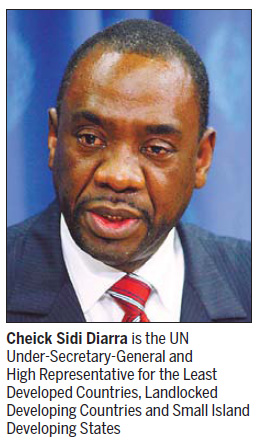Foreign and Military Affairs
More actions needed to sustain MDG progress
(China Daily)
Updated: 2010-09-22 12:06
 |
Large Medium Small |
China and India have helped reduce global poverty levels
UNITED NATIONS - Exactly 10 years ago, 189 heads of state gathered at the United Nations Millennium Summit in New York. They agreed to achieve a group of eight development goals from slashing poverty, expanding primary education, combating diseases such as HIV/AIDS and malaria, to boost global partnership for development. They set a deadline for these goals - 2015. 
With only five years left, 139 world leaders are meeting at the Millennium Development Goals (MDG) Summit (Sept 20 to 22) to review the progress and renew their commitment and give this historic promise a final push.
In an exclusive interview with China Daily, Cheick Sidi Diarra of Mali, UN Under-Secretary-General and High Representative for the Least Developed Countries, Landlocked Developing Countries and Small Island Developing States (OHRLLS), reviewed the progress that has been made, such as China's effort in poverty reduction, and expressed concerns about countries that are still lagging behind, including African countries and the least developed countries (LDCs).
"In general, the MDGs have made a lot of progress since the adoption in 2000, especially in some Asian countries because of economic growth," said Diarra. "In terms of poverty reduction (MDG Goal 1), countries like China and India have impacted on the global number."
According the 2010 MDG Report issued by the UN in June, the fastest growth and sharpest reductions in poverty continue to be recorded in East Asia. China and India have contributed to the large reduction in global poverty.
Target 1 in Goal 1 aims to cut in half, between 1990 and 2015, the proportion of people whose income is less than $1 a day.
"It was good that we had the benchmark, and it was the benchmark at the lower end, not the optimum solution because most of the middle-income countries have already reached the MDG targets. But it was meant for low-income countries, especially the least developed countries and African countries," Diarra said.
The United Nations Development Program (UNDP) said that China has now achieved the target of halving the number of poor people from the 1990 figure of 85 million.
Despite China's noticeable progress in poverty reduction, Diarra said the challenge for the country now is to meet the environmental targets (Goal 7).
"Some progress needs to be done in this area. But I think the problem is due to the size of the population of the country," he said, adding that the standard of living is improving for the average Chinese, which in turn has an impact on the style of living and contributes to the cause.
"This results in either you import a lot or grow a lot in the country. The latter puts a lot of pressure on the environment," he said.
"This has to be managed very delicately because on one hand you have to meet the minimum needs of the population, and on the other hand, you are working on achieving the goals," he said.
"My recommendation would be sustainable management of natural resources for the longer term. It would be a good policy for China in order to meet Goal 7 (ensuring environmental sustainability)."
Although the MDGs have made a real difference in many countries, unfortunately African countries are lagging behind in many target areas.
"The situation is worse in the LDCs (a group of 49 least developed countries in the world). They are lagging behind African countries," Diarra said, adding that financial and technical resources are among the things that are lacking.
For African countries, Goal 1 (eradicating extreme poverty and hunger) hasn't been successful, said Diarra, who is also the UN special advisor on Africa.







